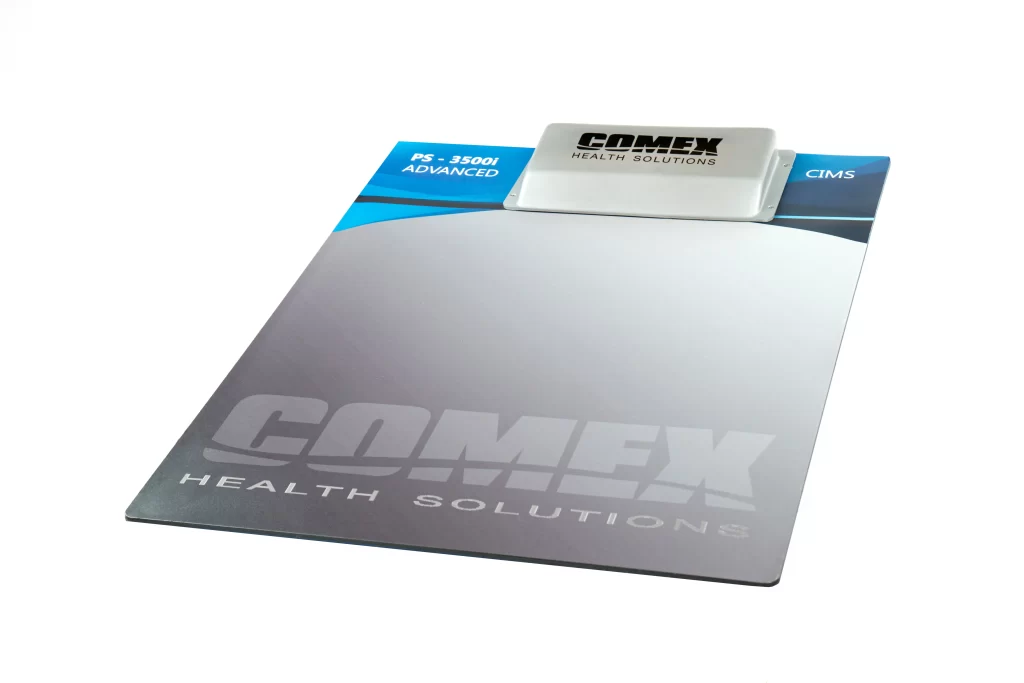tel: 210 9961192
HEALTH SOLUTIONS
COMEX
The only company in kinetic gait analysis and podiatry with customized orthotic insoles.
Foot Scanner
What is foot screening ?
The pedogram is a special carpet (dynamometer) with pressure sensors, on which we can stand and walk and in this way analyse our posture and gait. A kinetic analysis of gait is therefore carried out through which we can discover and diagnose anatomical variations and diseases not only of the lower limbs but of our entire skeleton. For example, anatomical variations and diseases such as flatfoot, flatfoot (high arch), anisocele, bellyfoot, bellyfoot, bellyfoot, ribofoot, hyperpronation, diabetic foot, neurological diseases, rheumatoid foot, sports injuries, etc. can not only be identified but also diagnosed in terms of severity, type, form, degree and distribution of stresses and their treatment can be planned. Then with a new palpogram the result of the treatment can be recorded. The palmatogram is a diagnostic method that is painless, repeatable, and without any radioactivity.
Here it should be stressed that the podiatry is not a method for the construction of a foot as even to give instructions for the construction of a foot, it is not enough to have only the podiatry, only then we have a customized foot for the specific patient and for the specific condition that has been diagnosed.
Every palpogram should be accompanied by a diagnosis (such as a CT or MRI scan) by a qualified doctor who has studied the subject. (foot & Ankle Fellowship)

What is a peltograph?
The palmatograph is a platform, which is connected to a computer (Stationary or Laptop) and records data on the anatomical morphology of the foot and the distribution of pressures during posture and gait. Based on this data, customized orthotic insoles are manufactured.
The pedogram enables us to perform a kinetic analysis of gait, so that the doctor can clearly distinguish the type, type and size of a possible problem in the lower limbs and posture.
The Pelmatograph system includes the measuring equipment and the special software ( Software ) necessary for the correct and accurate evaluation of gait.
The data from a static pedogram provides us with information about:
- the high plantar pressures exerted on the foot, and the average of these
- the patient's balance (stabilometry) in relation to the body's centre of gravity, or for each leg separately,
- the supporting surface,
- the position of the heel in relation to the forefoot, the loading of the arch of the foot, etc.
Depending on the software, it is possible to measure distances or even angles between axes of the examiner's preference, and two-dimensional and three-dimensional representations are available.
There is also a wealth of data from dynamic measurement where, in addition to the above, further analysis is given on :
- The residence time of the plantar pressures
- Cinematic analysis of pacing
- Categorisation of gait in phases (gait cycle)
- The average of the plantar pressures in line (COP line)
- Analysis and comparison between steps
- Separate individual analysis for any anatomical region.
Clinical Application
The data obtained from the measurement of plantar pressures can be used for the assessment and subsequent treatment of patients with a wide variety of foot disorders associated with neurological and/or musculoskeletal dysfunctions affecting children and adults.
Examples:
- In the field of sports injuries. It is possible to identify by means of a palpogram, random variations of intrinsic mobility. The term 'hypermobility' refers to abnormal bone mobility during loading of the limb. The leg is compressed and flattened excessively during loading, thus increasing its length. Fatigue syndromes, tendinitis and of course greater energy expenditure by the muscles are some of the consequences. Conversely, the foot with a high arch tends to be less elastic in its longitudinal axis and its plantar fascia is strained, resulting in it lagging behind in its function as a shock absorber, which has long-term pathological consequences. It is logical that the above effects do not only affect the limb but also the entire kinetic chain (knee, hip, back).
- In the pediatric field. Many gait disorders with inward/outward hip rotation, clubfoot, metatarsal adduction, rhabopodia, hippopodia, neurological disorders are some of the indications for pediatric podiatry.
- Metabolic diseases such as Diabetes Mellitus and the complications it brings to the limb. The identification of plantar pressures is considered of utmost importance to limit ulcerations and consequently amputations.
- In the surgical field. Pelvigraphy is performed before the operation and afterwards (after the relative rehabilitation stage) for an even more complete picture of the attending physician. Particularly operations on anatomical areas of the metatarsals and fingers, where now the loads will be different.
- In Rheumatoid arthritis where there are deformities and propria of the metatarsal heads, with anterior migration of fibrous tissue.
- Other conditions that affect the cerebellum and balance
Indeed the list could be quite long with each example being a separate chapter.
It is important to examine plantar pressures not only to support the diagnosis but more importantly to guide the treatment. In addition, the patient himself is also better educated by understanding, with graphical representations, his condition and/or its progress, thus helping the treating examiner more. Those health professionals involved in the diagnosis and treatment of pathological conditions affecting the limb, posture and gait would certainly find the information provided by means of a pedogram useful.
Conditions such as flatfoot, clubfoot, metatarsalgia, diabetic foot, rheumatoid foot, neurological foot, knee conditions (rhabdomyalgia, claudication, arthritis), lumbago can be diagnosed and their treatment can be planned, as well as we can study the postoperative outcome of surgical interventions.
Call us at 210.99.61.192 for any question you have about the Pellatogram !